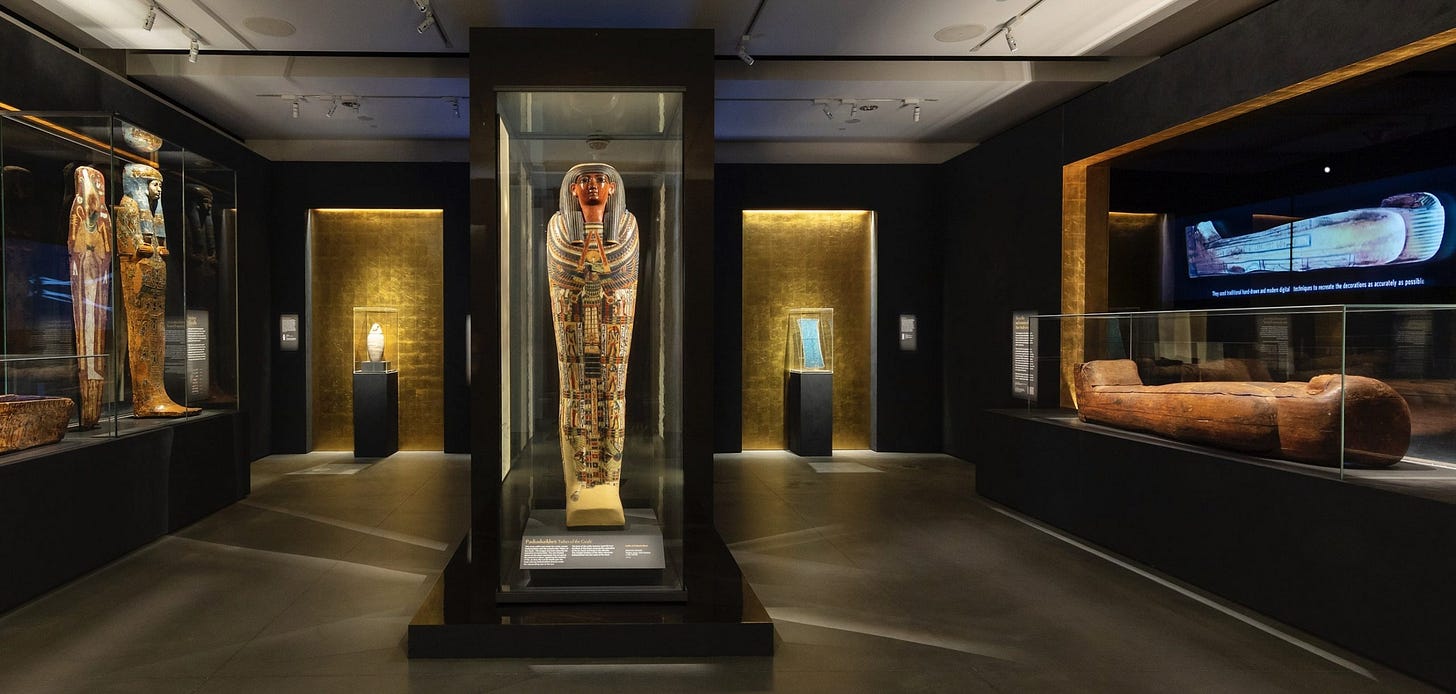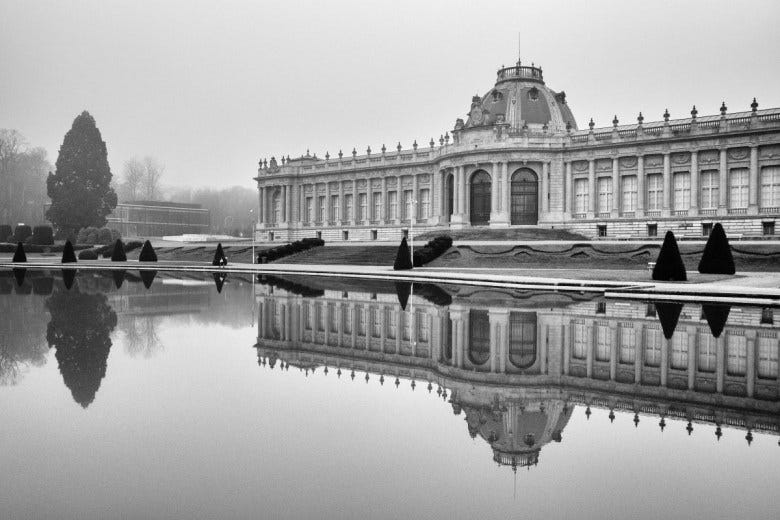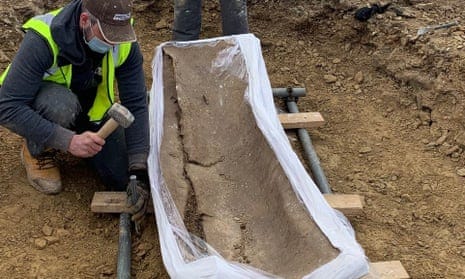Ancient/Now - March 27th
The debate on the ethical display of human remains, what DNA reveals about hunter-gatherer populations in Europe, and how museums can overcome their colonial legacy
Is there such a thing as ethical display of human remains?

The conversation on how to handle the display of human remains in museums is ongoing. This Egyptian Streets article specifically considers ancient Egyptian mummified remains and asks the question as to whether or not there is such a thing as ethical display of human remains, at all. There is the alternative, rather Marxist, perspective: if rich ancient Egyptians displayed non-decayed bodies in precious body containers, then the expectation of later attention should be a given… No matter one’s perspective, there is agreement that it is important to avoid objectifying mummified remains and to turn museum visitors’ attention to humanity, to people. But meeting these criteria can look different to different people, depending on their individual, academic, and cultural perspectives (Are you an Egyptian? Are you an Egyptian scholar? Are you not Egyptian and studying Egyptians? etc, etc). While a consensus on the display of human remains in museums remains unmet, conversations and questions like the ones reflected in this article are happening across the museum world, in social media, and that is encouraging, in and of itself….
Ending the colonial legacy of museums

Keeping with the theme of asking difficult questions and having the conversations necessary to improve cultural institutions like museums, this incisive Hyperallergic article by Dr. Kellie Morgan, Professor of the Practice and the inaugural Director of Curatorial Studies at Tufts University and curator, tackles the question of whether museums will ever be able to rid themselves of their colonial legacy. Many museums have made genuine, good-faith efforts to address the colonial origins of museum collecting and inequities in representation and access. But most museums are nonetheless founded on the extraction and hoarded control of cultural goods not owned by their cultural stakeholders. Most museums are filled with objects removed from their lived, ritual experiences, put into display cases, sterilized, their raison d’être destroyed, if you will. Obviously, there is still much room left for improvement. As Dr. Morgan writes,
Museum history of possession and voracious accumulation is why my curatorial investigations begin with Black scholars. Writing more than 30 years apart, W.E.B. Du Bois at the end of World War I and Aimé Césaire a decade after World War II, each man exposed the colonialist psyche that led us to world war not once but twice. Their works provided readers with poignant ways to understand colonization, its various forms, and its effects on our lives. This tradition among BIPOC cultural producers is more than 300 years old. But how often are ideas posited by BIPOC scholars being strategically applied to museum history and practice? Not nearly enough.
It remains to be seen whether museums will ever truly be able to escape the colonial legacy that haunts them, but as Dr. Morgan points out, simply representing BIPOC cultures in museums will not result in systemic or structural change within institutions:
Although the aesthetic presence of BIPOC work in museums is indispensable and allows room for pure visual appreciation, genuine equity will not develop until its multivalent cultural and aesthetic patterns are fully incorporated into how and why the gallery/museum is there in the first place. The work must be contextualized through BIPOC epistemologies.
We partially tackle this question in this upcoming Monday’s podcast episode, “March Patreon Q&A”— check it out!
Roman woman’s remains discovered in a lead coffin in England
The Guardian reported this month on the discovery of a lead coffin with the remains of an aristocratic woman at Garforth, an archaeological site near Leeds. (See above about rich people with tricked-out, fancy burial contexts and ask whether scholars should ignore such materiality due to moral scruples.) The remains are around 1,600 years old and date to sometime between the fall of the Roman Empire ca. 400 CE to the beginning of the Anglo-Saxon period in England.
Unusually for an ancient cemetery, the remains found in Garforth belonged to people from the late Roman and the early Saxon eras. The skeleton of the late Roman aristocratic woman was found alongside the remains of 60 men, women and children from the two periods.
Early indications suggest that the people buried in the cemetery practiced early Christian beliefs, an exciting lead in the social research. The Leeds City Museum plans to display the lead coffin in an upcoming exhibition on funerary customs around the world…which leads us to ask: what do we think about separating body from body container? Is it appropriate? Whom does it serve? And, Kara wants to know: how much money did all of that lead cost and where in the world did they source it?
2,700 year old temple remains discovered in Sudan
Archaeologists with the Polish Centre of Mediterranean Archaeology at the University of Warsaw have uncovered the remains of a 2,700 year old temple between the third and fourth cataracts of the Nile River in modern-day Sudan, an area known in ancient times as the kingdom of Kush. Among the fragments they discovered are those with inscriptions, including one that states that the temple was dedicated to Amen-Re of Kawa. While it is clear that these are the remains of a temple, researchers speculate that it is possible that the temple fragments were transported to this site from another larger ancient site in Sudan known as Gebel Barkal. Reuse was the norm, one might argue, not the exception! It was not unusual for people in the past to break down monuments when stone or other materials were needed for construction, and archaeologists cannot yet rule out this possibility.
NYT: DNA reveals previously unknown populations of early Europeans
Before DNA, we relied on technology historians, anthropologists, and archaeologists to piece together our knowledge about early hunter-gatherer populations in Europe, using evidence like stone tools, cave paintings, and “fertility” figurines. But now, using DNA extracted from teeth and bones (in this case 357 ancient European individuals), scientists can now form a genetic record of early populations in Europe, as:
…researchers discovered that several waves of hunter-gatherers migrated into Europe. The studies identified at least eight populations, some more genetically distinct from each other than modern-day Europeans and Asians. They coexisted in Europe for thousands of years, apparently trading tools and sharing cultures. Some groups survived the Ice Age, while others vanished, perhaps wiped out by other groups.
Dr. Villalba-Mouco and her colleagues have given these peoples a list of new names that can be as hard to memorize as the kingdoms of Westeros: the Fournol, the Vestonice, the GoyetQ2, the Villabruna, the Oberkassel and the Sidelkino, among others.
Researchers did not expect to find this portrait of multiple populations with different ancestry, perhaps suggesting a world of moving peoples, maybe even in turmoil. Such findings are raising many more questions than they are answering, but the fact remains that without DNA technology we wouldn’t have the details about different streams of hunter-gatherer populations in Europe and their movements across the continent. DNA is an archaeology, in and of itself, and like digging up sites, the revelations can be disturbing and even misused. We exhort you to use all your critical thinking when DNA discussions of antiquity enter the media because there are always dozens of unexpressed and non-verbalized nationalistic, religious, and colonial cultural claims.








